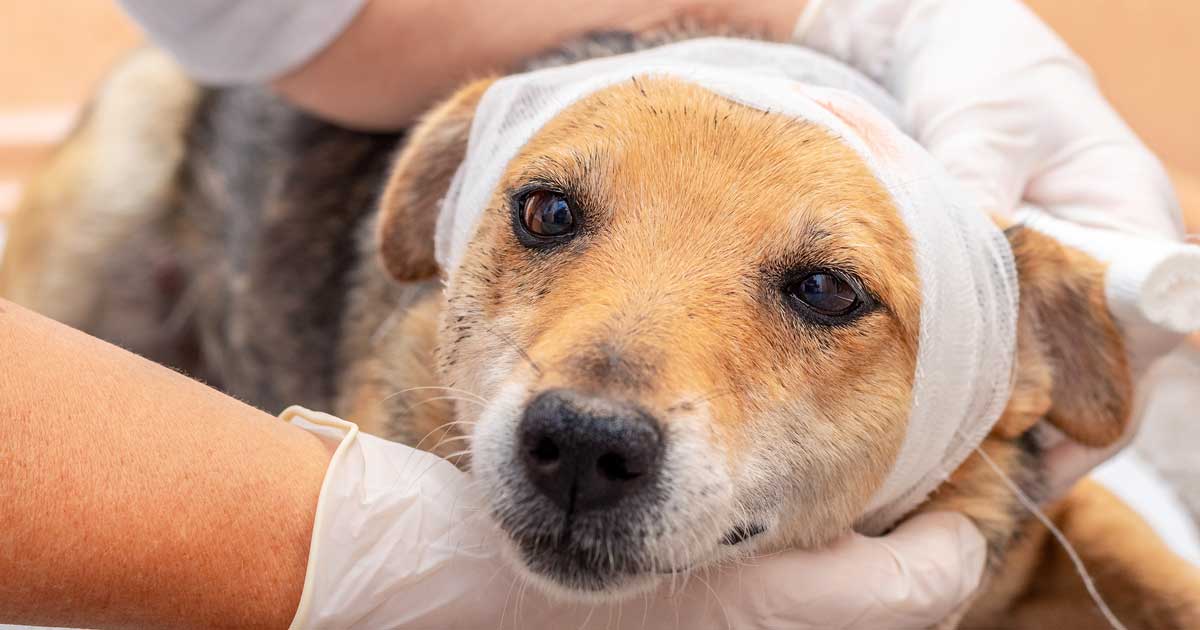15 Nov 2022
Victoria Bowes discusses causes of these presentations in practice, the importance of swift triage and admittance, as well as nursing the patient.

Image © Volodymyr / Adobe Stock

Unfortunately, it is commonplace for patients with head traumas to be admitted to the emergency and general veterinary practice.
Various causes for head trauma exist, including road traffic collisions, being stepped on by owners and falling. Any animal that has had a head trauma must be advised to attend the veterinary practice straightaway, as it requires immediate medical attention.
Unfortunately, due to the nature of head injuries, other concurrent problems may present at the same time. It is paramount the animals are triaged, and admitted for treatment and stabilisation without delay.
Animals may be admitted with two types of head traumas:
It is important that triage and initial assessment of the head trauma patient is completed as soon as it arrives on the premises.
The initial assessment should evaluate the patient’s cardiovascular and respiratory systems (O’Dwyer, 2018). Using the pneumonic ABC will guide the key areas for triage of the patient. It is also important to remember that many patients with head traumas will have other injuries possibly relating to the spine, so they must be handled gently and with care.
It is important to identify if any of the aforementioned is not within normal ranges, as the patient may require emergency intervention as directed by the vet (Terry, 2010). As part of the assessment, a modified Glasgow coma scale (MGCS; Bush Veterinary Neurology Service, 2016) should be completed on the patient.
It is important to complete the neurological assessment and a recognised mentation assessment, such as MGCS, prior to providing any medication to the patient, as this can affect the assessment. However, it is important to remember these patients benefit from supplementary oxygen on admission and throughout the recovery period.
The MGCS is a method to assess the survival likelihood up to 48 hours in dogs with traumatic brain injury. The assessment looks at initial neurological status, as well as the changes in clinical signs.
Three areas are to be assessed, including level of consciousness, posture and pupillary size, and light response. The score ranges from 3 to 18, with the lower scores indicating severe neurological dysfunction (O’Dwyer, 2018). It is important to recognise that patients’ systemic problems can impact neurological functioning. (Fletcher, 2012).
The neurological assessment comprises of a physical assessment, which looks at the various neurological responses to stimulus. It is important the assessment be completed as soon as the patient is stable enough, but one must be aware that head trauma patients can have subtle changes and deteriorate quickly.
When assisting with the assessment, it is important to handle the patient gently, and ensure the head, neck and spinal cord are supported at all times. If any fractures are suspected, thorough discussion with the veterinary team should be completed so the safest way to handle the patient for the assessment can be planned. Careful positioning of the head and neck ensures no occlusion of the jugular vein, as this can decrease venous return from the brain, which can lead to increased intra-cranial pressure and can cause intra-cranial haemorrhage (O’Dwyer, 2018).
The physical examination will look at levels of consciousness, which should be reviewed regularly to monitor for improvement or decline.
The key definitions for levels of consciousness are:
While being assessed, the patient’s body position will enable the veterinary surgeon to assess the severity of the brain injury and prognosis. If the patient is presenting recumbent and defined as comatose, with all its limbs extended and the head dorsiflexed, this is classed as decerebrate rigidity and is indicative of severe brainstem injury, along with a grave prognosis.
Decerebellate is where the forelimbs are extended and the hindlimbs are flexed. This is less severe, and some patients will show some signs of consciousness and pupillary response (O’Dwyer, 2018; Rylander, 2013).
The patient requires continuous monitoring, and the following clinical signs should be monitored and recorded accurately:
Any changes and regular recording should be immediately communicated with the veterinary surgeon.
It should have a designated nurse who will monitor the patient, so any changes can be noted immediately and discussed with the veterinary surgeon. As discussed, patients suffering with head trauma can deteriorate quickly. Most patients will require supplementary oxygen therapy throughout their stay. They may also require artificial oxygen ventilation support.